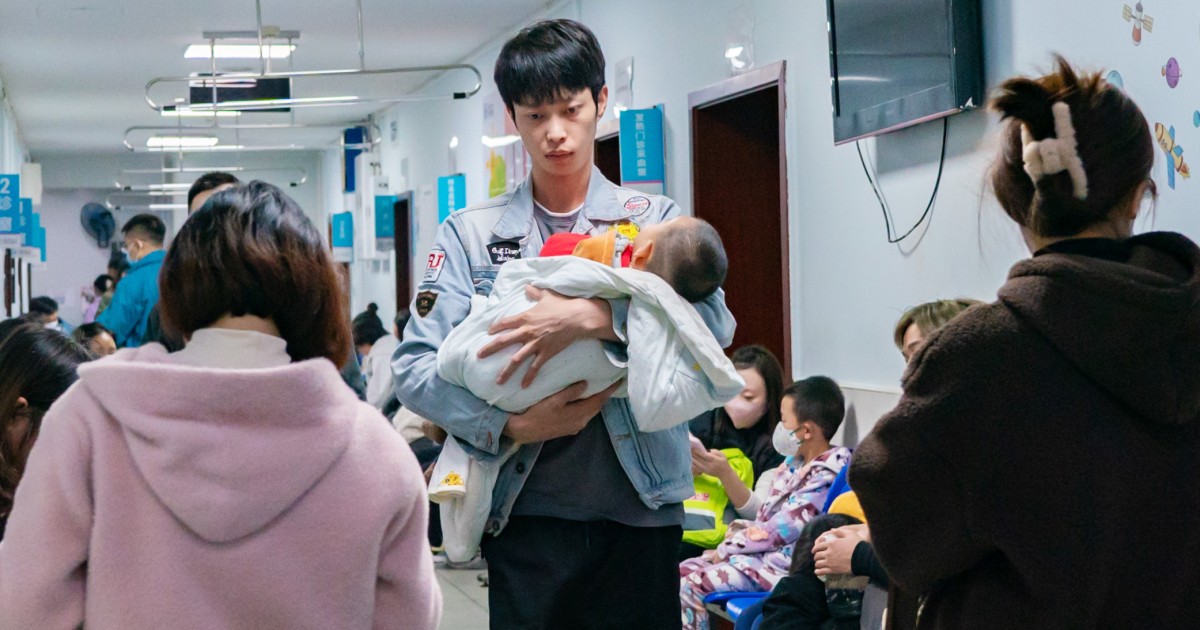An Ohio county is experiencing a pediatric pneumonia outbreak, including several cases of mycoplasma pneumonia or white lunga disease that has caused recent outbreaks among children in Denmark and China.
The Warren County Health District said Thursday it has had an unusually high number of pediatric pneumonia cases this fall: 145 since August. The average patient is about 8 years old, according to the district, and the most common symptoms have been cough, fever and fatigue. No deaths have been reported and illnesses are no more severe than in previous years, the district said in a news release.
Cases of mycoplasma pneumonia have reached epidemic levels in Denmark and have contributed to an increase in hospital admissions in China. Taiwan’s Health Ministry said Thursday that older adults, young children and people with poor immunity should avoid traveling to mainland China, Hong Kong or Macau due to an increase in respiratory illnesses there, which also include outbreaks of flu, adenovirus and respiratory syncytial virus (RSV).
The Centers for Disease Control and Prevention (CDC) has been in communication with its counterpart in China “to make sure we understand the situation there,” its director, Dr. Mandy Cohen, said Thursday. , at a hearing of the House Energy and Commerce Committee.
“We don’t believe this is a new or novel pathogen,” he said.
The Warren County Health District in Ohio also said it did not suspect a new respiratory virus was causing the outbreak, noting that “there has been no evidence that this outbreak is related to other outbreaks, either at the state level, national or international.”
What is mycoplasma pneumonia?
Mycoplasma pneumonia is caused by bacteria that can spread through small droplets when an infected person coughs or sneezes. The bacteria can stay in the nose and throat without making a person sick, but can cause pneumonia if it spreads to the lungs.
Mycoplasma pneumonia is usually a milder form of pneumonia, but its symptoms may last longer. Cases tend to peak every three to seven years in the United States.
“It’s sometimes known as ‘walking pneumonia,’ which means you have pneumonia but you’re not sick enough to be in the hospital,” said Dr. James Cutrell, associate professor of infectious diseases at the UT Southwestern Medical Center in Dallas.
In older children and adults, initial mycoplasma infections often resemble chest colds and may include a sore throat, fever, headaches, or a worsening cough that lasts weeks to months, according to the CDC. Children under 5 years old often develop cold-like symptoms, such as sneezing, stuffy nose, sore throat, diarrhea, or vomiting.
Young children are more likely to have severe cases that progress to pneumonia, especially if their immune systems are weak or they have never been exposed to the bacteria before. Symptoms of pneumonia, which include cough, fatigue, shortness of breath, fever and chills, usually appear one to four weeks after someone becomes infected.
The World Health Organization said last week that China has reported an increase in hospitalization of children with mycoplasma pneumonia since May.
Cases in Denmark have also increased since the summer, according to the Statens Serum Institut, a Copenhagen-based research group that is part of the Danish Ministry of Health.
On Wednesday it reported that cases of mycoplasma pneumonia have increased significantly over the past five weeks. Denmark recorded 541 new cases in the week ending November 26, more than triple the number recorded three weeks earlier.
Sweden, Switzerland and Singapore also recorded more than 100 cases each between April and September, according to a study published last week in The Lancet Microbe.
Why are outbreaks happening now?
Infectious disease experts said the outbreaks are cause for increased vigilance, but not panic, in the United States.
“There is nothing to suggest that this is a more dangerous strain of bacteria,” Cutrell said. “There is certainly no evidence to suggest that this is a new bacteria.”
Experts say there are clear reasons why the number of cases is rising now: First, countries traditionally have surges in mycoplasma pneumonia every few years, so some outbreaks may be part of the seasonal ebb and flow of the diseases. respiratory.
“It may be that in places like Denmark, there was a cycle,” said Dr. Amesh Adalja, an infectious disease physician and senior scholar at the Johns Hopkins Center for Health Security.
Fewer social interactions during the pandemic also meant the bacteria didn’t have much opportunity to spread in recent years. Now that more children are interacting again in school, daycare and other social settings, some countries are experiencing resurgences.
China’s outbreak in particular is not a surprise, given the country’s strict lockdown measures, said Michael Osterholm, director of the Center for Infectious Diseases Research and Policy at the University of Minnesota.
“They really had a complete shutdown of all infectious diseases,” Osterholm said. “So I would have expected exactly what we are seeing now.”
Cutrell said some countries could have worse than usual outbreaks this year because many young children have not yet been exposed to the bacteria and therefore lack immunity. The same goes for other respiratory illnesses, like the flu or RSV, he added.
“We are seeing increases in respiratory infections in general, but in particular they look like mycoplasmas,” he said. “It’s simply because we have a larger group of people who are more susceptible.”
Doctors treat mycoplasma pneumonia, like other forms of pneumonia, with antibiotics; However, only certain forms, such as azithromycin (also known as Z-Pak), are effective against it.
Although the disease is relatively easy to treat, Osterholm said staffing shortages or a lack of pediatric beds in hospitals could pose challenges this winter.
“Hospitals can be overwhelmed” by a number of patients “that 10 years ago would have been normal,” said the specialist.

